Breeding And Biotechnology Notes 10th Science Lesson 20 Notes in English
Breeding And Biotechnology
Introduction
- India’s population is likely to reach 1.7 billion by 2050. Current rate of India’s food production will be able to meet only 59% of the country’s food demand at that time.
- This can be made possible by ‘Plant breeding’ and ‘Animal husbandry’. Plant breeding is the art of developing economically important plants with superior quality. Animal husbandry involves the breeding of animals.
- It aims at improving the genotypes of animals to make them more useful to the welfare of mankind.
- This emphasizes domestication and propagation of animals, under controlled conditions to enhance food production and food quality.
- Another breakthrough was the emergence of biotechnology as an entity of modern biology, which paved way to develop advanced healthcare products, diagnostic kits and food production to improve the quality of human life.
Modern Agricultural Practices and Crop Improvement
- Modern agricultural practices are activities carried out to improve cultivation of plants. It includes preparation of soil, sowing, application of manures and fertilizers, proper irrigation, protection from weeds and pests harvesting, threshing and storage.
- The aim of crop improvement is to develop improved crop varieties possesing higher yield, better quality, resistance to diseases and shorter duration.
Green Revolution
- Green Revolution is the process of increasing food production through high yielding crop varieties and modern agricultural techniques in underdeveloped and developing nations.
- Dr. Norman E. Borlaug, an American agronomist the “Father of the Green Revolution”, received the Nobel Peace Prize in 1970.
- In India Dr. M. S. Swaminathan joined with Dr.Borlaug in bringing Green Revolution by introducing Mexican wheat varieties. This eventually increased wheat and rice production between 1960 and 2000.
Breeding for high yield and better quality
Major challenge that India faced during post-independance period was having enough food production for the growing population. Efforts were taken to develop high yielding varieties of crops, leading to Green Revolution.
Semi-Dwarf varieties in Wheat and Rice
- Sonalika, Kalyan Sona are semi-dwarf varieties of wheat developed from high yielding, semi-dwarf, fertilizer responsive wheat varieties from Mexico. IR-8 (Miracle rice) is a high-yielding semi-dwarf rice variety developed by International Rice Research Institute (IRRI), Philippines.
- In 1966, this was first introduced in Philippines and India. It was a hybrid of a high yielding rice variety Peta from Indonesia, and Dee-geo-woo-gen (DGWG) a dwarf variety from China.
Plant Breeding for Disease Resistance

- Plant diseases are caused by pathogens like viruses, bacteria and fungi. This affects crop yield.
- Hence, it is important to develop disease resistant varieties of crops, that would increase the yield and reduce the use of fungicides and bactericides.
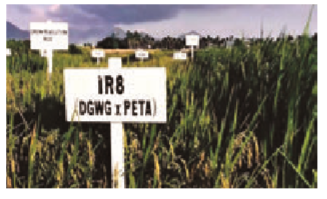
Plant Breeding for Insects/Pests Resistance
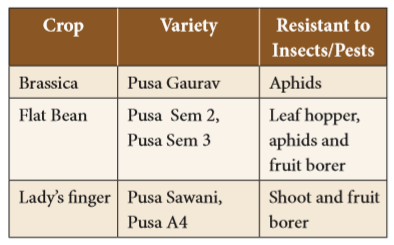
- In addition to microorganisms, a large number of insects and pests also cause damage to the crops. Hence, insect and pest resistant crop varieties were developed.
- Plant Breeding for Improved Nutritional Quality Undernutrition and protein malnutrition among human population is a major health problem which has been receiving much focus throughout the world.
- Apart, from humans it also affects the health of farm animals. To combat these conditions, human and animal health are to be determined by the nutritional quality of the feed crops.
- The nutritional quality of crops depends on quality and quantity of nutrients. The nutritional quality may be improved with respect to its
1. Protein content and quality of protein
2. Oil content
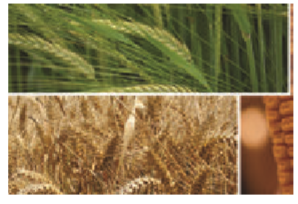
3. Mineral content
Biofortification
- Biofortification is the scientific process of developing crop plants enriched with high levels of desirable nutrients like vitamins, proteins and minerals.
- Some examples of crop varieties developed as a result of biofortification are given below:
1. Protina, Shakti and Rathna are lysine rich maize hybrids (developed in India).
2. Atlas 66, a protein rich wheat variety.
3. Iron rich fortified rice variety. 4
. Vitamin A enriched carrots, pumpkin and spinach
Methods of Plant Breeding for Crop Improvement
Methods of plant breeding to develop high yielding varieties are given below:
1. Introduction of new varieties of plants
2. Selection
3. Polyploidy breeding
4. Mutation breeding
5. Hybridization
Introduction of New Varieties of Plants
- It is a process of introducing high yielding varieties of plants from one place to another. Such plants are called as exotic species.
- These imported plant materials may carry pathogens and pests, hence they are thoroughly tested in a plant quarantine before being introduced to the fields. e.g Phaseolus mungo was introduced from China.
Selection
Selection is one of the oldest methods of plant breeding in which individual plants or groups of plants are sorted out from a mixed population based on the morphological characters.
Methods of selection
There are three methods of selection. They are
1. Mass selection
2. Pureline selection
3. Clonal selection
1. Mass selection
- Seeds of best plants showing desired characters are collected from a mixed population. The collected seeds are allowed to raise the second generation. This process is carried out for seven or eight generations.
- At the end, they will be multiplied and distributed to the farmers for cultivation. Some common examples for mass selection are groundnut varieties like TMV–2 and AK–10. Its schematic representation is given below
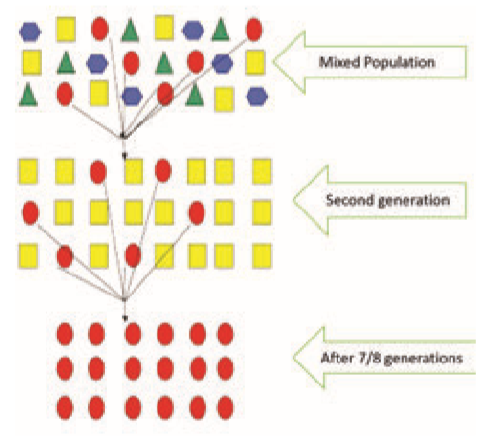
2. Pureline selection
- Pureline is “the progeny of a single individual obtained by self breeding”. This is also called as individual plant selection.
- In pureline selection large numbers of plants are selected from a self-pollinated crop and harvested individually.
- Individual plant progenies from them are evaluated separately. The best one is released as a pureline variety. Progeny is similar both genotypically and phenotypically.
3. Clonal selection
- A group of plants produced from a single plant through vegetative or asexual reproduction are called clones.
- All the plants of a clone are similar both in genotype and phenotype. Selection of desirable clones from the mixed population of vegetatively propagated crop is called clonal selection.
Polyploidy Breeding
- Sexually reproducing organisms have two complete set of chromosomes in their somatic cells. This is called diploid (2n).
- The gametic cells have only one set of chromosome.
- This is called haploid (n). An organism having more than two sets of chromosomes is called polyploid (Greek : Polys = many + aploos = one fold + eidos = form).
- Such condition is called Polyploidy. It can be induced by physical agents such as heat or cold treatment, X-rays and chemical agents like colchicine.
Achievements of polyploidy breeding
Some achievements of polyploidy breeding are
a. Seedless watermelons (3n) and bananas (3n).
b. TV-29 (triploid variety of tea) with larger shoots and drought tolerance.
c. Triticale (6n) is a hybrid of wheat and rye. To make this plant fertile polyploidy is induced. It has higher dietary fibre and protein.
d. Raphano brassica is an allotetraploid by colchicine treatment.
Mutation Breeding
- Mutation is defined as the sudden heritable change in the nucleotide sequence of DNA in an organism.
- It is a process by which genetic variations are created which in turn brings about changes in the organism.
- The organism which undergoes mutation is called a mutant. The factors which induce mutations are known as mutagens or mutagenic agents.
- Mutagens are of two types namely physical mutagens and chemical mutagens.
i Physical mutagens
Radiations like X-rays, α, β and γ-rays, UV rays, temperature etc. which induce mutations are called physical mutagens
ii Chemical mutagens
Chemical substances that induce mutations are called chemical mutagens. e.g. Mustard gas and nitrous acid. The utilisation of induced mutation in crop improvement is called mutation breeding.
Achievements of mutation breeding
Some achievements of mutation breeding are
a. Sharbati Sonora wheat produced from Sonora-64 by using gamma rays.
b. Atomita 2 rice with saline tolerance and pest resistance c. Groundnuts with thick shells
Hybridization
- Hybridization may be defined as the process of crossing two or more types of plants for bringing their desired characters together into one progeny called hybrid. Hybrid is superior in one or more characters to both parents.
- Hybridization is the common method of creating genetic variation to get improved varieties.
Hybridization Experiment: Triticale (The first man – made cereal)
- Triticale is the first man- made cereal hybrid. It is obtained by crossing wheat (Triticum durum, 2n = 28) and rye (Secale cereal, 2n = 14). The F1 hybrid is sterile (2n = 21).
- Then the chromosome number is doubled using colchicine and it becomes a hexaploid Triticale (2n = 42). The cycle of crop raising and selection continues till the plants with the desired characters are finally obtained.
- The development of new varieties is a long-drawn process. Two main aspects of hybridization are to combine the characters of two plants in one plant and to utilize hybrid vigour.
Animal Breeding
- A breed is a group of animals of common origin within a species that has certain distinguishing characters that are not found in other members of the same species like general appearance and others striking features.
- Breeding involves mating parents of different varieties each having some desired trait which are passed onto the offspring.
Objectives of Animal Breeding
- Animal breeding aims at improving the genotypes of domesticated animals to increase their yield and improve the desirable qualities to produce milk, egg and meat.
- When breeding takes place between animals of the same breed, it is called inbreeding. The cross between different breeds is called outbreeding.
Inbreeding
- Inbreeding refers to the mating of closely related animals within the same breed for about 4-6 generations.
- Superior males and superior females of the same breed are identified and mated in pairs. It helps in the accumulation of superior genes and elimination of genes which are undesirable.
- Hissardale is a new breed of sheep developed in Punjab by crossing Bikaneri (Magra) ewes and Australian Marino rams.
Inbreeding depression:
Continued inbreeding reduces fertility and productivity. Inbreeding exposes harmful recessive genes that are eliminated by selection.
Outbreeding
- It is the breeding of unrelated animals. The offsprings formed are called hybrids. The hybrids are stronger and vigorous than their parents.
- Cross between two different species with desirable features of economic value are mated. Let’s see what cross produce a mule.

- Mule is superior to horse in strength, intelligence, ability to work and resistance to diseases but they are sterile.
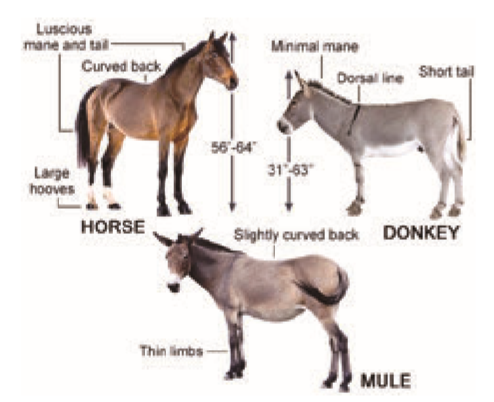
Cross breeding to produce Mule with superior characters
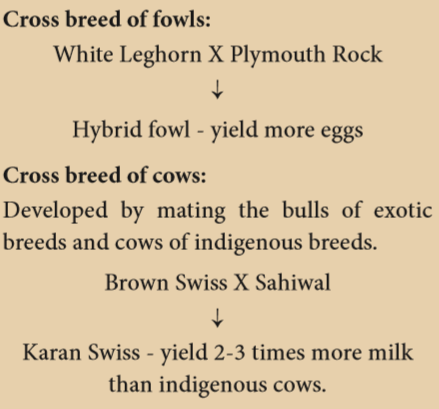
Heterosis
The superiority of the hybrid obtained by cross breeding is called as heterosis or hybrid vigour.
Effects of hybrid vigour in animal breeding
- Increased production of milk by cattle
- Increased production of egg by poultry
- High quality of meat is produced
- Increased growth rate in domesticated animals
Genetic Engineering:
- Genetic engineering is the manipulation and transfer of genes from one organism to another organisms to create a new DNA called as recombinant DNA (rDNA).
- The term recombinant is used because DNA from two different sources can be joined together. Hence, genetic engineering is also called as recombinant DNA technology.
Techniques of Genetic Engineering – Basic Requirements
Important discoveries that led to the stepping stone of rDNA technology were
a. Presence of plasmid in bacteria that can undergo replication independently along with chromosomal DNA.
b. Restriction enzymes cuts or break DNA at specific sites and are also called as molecular scissors.
c. DNA ligases are the enzymes which help in ligating (joining) the broken DNA fragments.
Gene Cloning

Genetic engineering technique (Gene cloning)
- What reminds to your mind when you hear the word clone? Of course, ‘DOLLY’ the cloned sheep. The carbon copy of an individual is oft en called a clone. However, more appropriately, a clone means to make a genetically exact copy of an organism.
- In gene cloning, a gene or a piece of DNA fragment is inserted into a bacterial cell where DNA will be multiplied (copied) as the cell divides.
- A brief outline of the basic steps involved in gene cloning are:
- Isolation of desired DNA fragment by using restriction enzymes
- Transfer of rDNA into bacterial host cell (Transformation)
- Selection and multiplication of recombinant host cell to get a clone
- Expression of cloned gene in host cell. Using this strategy several enzymes, hormones and vaccines can be produced.
Biotechnology in Medicine
Using genetic engineering techniques medicinally important valuable proteins or polypeptides that form the potential pharmaceutical products for treatment of various diseases have been developed on a commercial scale.
Pharmaceutical products developed by rDNA technique
a. Insulin used in the treatment of diabetes.
b. Human growth hormone used for treating children with growth deficiencies.
c. Blood clotting factors are developed to treat haemophilia.
d. Tissue plasminogen activator is used to dissolve blood clots and prevent heart attack.
e. Development of vaccines against various diseases like Hepatitis B and rabies
Gene Therapy
- Gene therapy refers to the replacement of defective gene by the direct transfer of functional genes into humans to treat genetic disease or disorder.
- The genetic makeup of the ‘patient’ cell is altered using recombinant DNA technology. It was first successfully implemented in 1990.
- Somatic gene therapy is the replacement of defective gene in somatic cells. Germ line gene therapy replacement of defective gene in germ cell (egg and sperm).
- Gene therapy conducted till date has targeted only somatic (non-reproductive) cells.
- Correction of genetic defects in somatic cells may be beneficial to the patient but the corrected gene may not be carried to the next generation.
Stem Cells
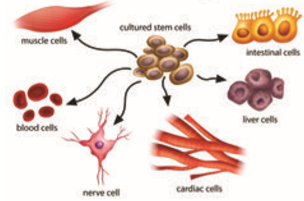
- Our body is composed of over 200 specialised cell types, that can carry out specific functions. e.g. neurons or nerve cell that can transmit signals, or heart cells which contract to pump blood or pancreatic cells to secrete insulin.
- These specialised cells are called as differentiated cells. In contrast to differentiated cells, stem cells are undifferentiated or unspecialised mass of cells.
- The stem cells are the cells of variable potency. Potency refers to the number of possible fates that a cell can acquire.
- The two important properties of stem cells that differentiate them from other cells are:
- its ability to divide and give rise to more stem cells by self-renewal
- its ability to give rise to specialised cells with specific functions by the process of differentiation.
Types of stem cells
- Embryonic stem cells can be extracted and cultured from the early embryos. These cells are derived from the inner cell mass of blastocyst.
- These cells can be developed into any cell in the body. Adult stem cell or somatic stem cell are found in the neonatal (new born) and adults.
- They have the ability to divide and give rise to specific cell types. Sources of adult stem cells are amniotic fluid, umbilical cord and bone marrow.
Stem-cell therapy
- Sometimes cells, tissues and organs in the body may be permanently damaged or lost due to genetic condition or disease or injury.
- In such situations stem cells are used for the treatment of diseases which is called stem-cell therapy.
- In treating neurodegenerative disorders like Parkinson’s disease and Alzheimer’s disease neuronal stem cells can be used to replace the damaged or lost neurons.
DNA Fingerprinting Technology
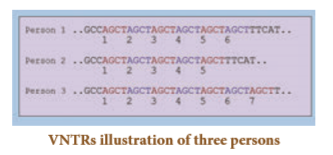
- The human genome has 3 billion base pairs. Did you know that the DNA pattern of two individuals cannot be same except for identical twins.
- Each person’s DNA sequence is unique due to the small difference in the base pairs.
- Therefore, if we want to compare the genetic difference among the two individuals, DNA fingerprinting is the easier and quicker method.
- This technique was developed by Alec Jeffrey. The technique analyses each individual’s unique DNA sequences and provides distinctive characteristics of individual which helps in identification.
- Variable number of tandem repeat sequences (VNTRs) serves as molecular markers for identification.
- In human beings, 99 % of the DNA base sequences are the same and this is called as bulk genomic DNA.
- The remaining 1 % DNA sequence differs from one individual to another. This 1 % DNA sequence is present as small stretch of repeated sequences which is known as satellite DNA.
- The number of copies of the repeat sequence also called as VNTRs differs from one individual to another, and results in variation in the size of the DNA segment.
- As shown in the illustration, the sequence AGCT is repeated six times in first person, five times in second person and seven times in third person.
- Because of this, DNA segment of third person will be larger in size followed by DNA segment of first person and then the second person.
- Thus, it is clear that satellite DNA bring about variation within the population. Variation in DNA banding pattern reveals differences among the individuals.
Applications of DNA Fingerprinting
- DNA fingerprinting technique is widely used in forensic applications like crime investigation such as identifying the culprit. It is also used for paternity testing in case of disputes.
- It also helps in the study of genetic diversity of population, evolution and speciation.
Genetically Modified Organisms (GMOs)
- One of the most tremendous development of genetic engineering is the production of genetically modified (GM) plants and animals.
- Genetic modification refers to the alteration or manipulation of genes in the organisms using rDNA techniques in order to produce the desired characteristics.
- The DNA fragment inserted is called transgene. Plants or animals expressing a modified endogenous gene or a foregin gene are also known as transgenic organisms.
- The transgenic plants are much stable, with improved nutritional quality, resistant to diseases and tolerant to various environment conditions.
- Similarly transgenic animals are used to produce proteins of medicinal importance at low cost and improve livestock quality. Some examples of genetically modified plants and animals are given in the table below.
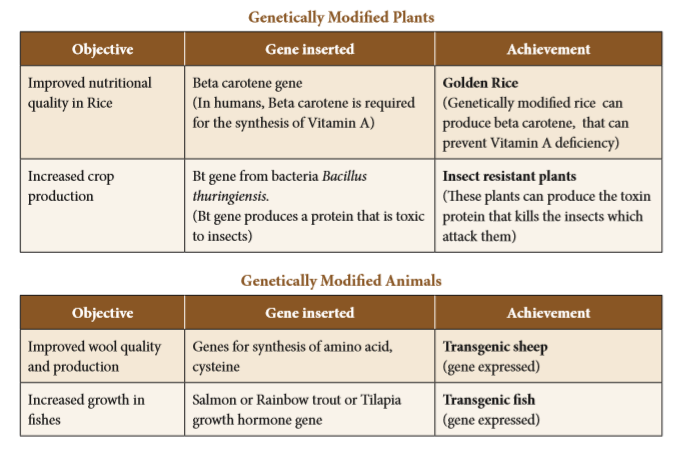
More to Know:
1. Dr. M. S. Swaminathan
Dr. Mankombu Sambasivan Swaminathan is an Indian scientist known for his leading role in India’s Green Revolution. His research on potato, wheat, rice and jute are well known plant breeding experiments. Due to his efforts the wheat production increased from twelve million tonnes in 1960’s to seventy million tonnes now. He is aptly called as the “Father of Indian Green Revolution.
2. Dr. G. Nammalvar
Dr. G. Nammalvar (1938-2013) was a Tamil agricultural scientist, environmental activist and organic farming expert. He founded Nammalvar Ecological Foundation for Farm Research and Global Food Security Trust (NEFFFRGFST Vanagam) to create public awareness about the benefits of organic farming.
3. Gamma Garden
Gamma garden or Atomic garden is a concept popularised after World War II for the peaceful use of atomic energy for crop improvement. This is a type of induced mutation breeding where radioactive sources particularly gamma rays from Cobalt-60 or Caesium-137 are used to induce desirable mutations in crop plants
4. Plasmid is the small circular double stranded DNA molecule found in the cytoplasm of bacterial cell and separated from chromosomal DNA. It can replicate independently.

5. Restriction enzymes recognises a specific base pair sequence (palindromic sequence) in DNA called as restriction site and cleaves the phosphodiester bond within DNA.
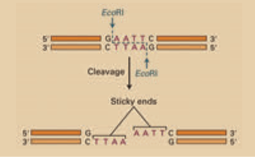
6. Development of Dolly
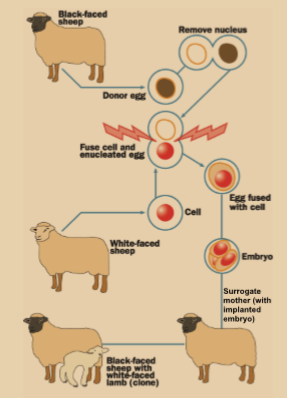
Dolly was the first cloned female sheep, developed by Dr. Ian Wilmut and his colleagues at the Roslin Institute, Scotland in July 1996. She was created by somatic cell nuclear transfer technique. She lived for 6.5 years and died in 2003 because of lung disease.
7. Eli Lilly and Company, United States, in 1979 first started commercial production of human insulin by using rDNA technology.